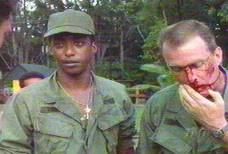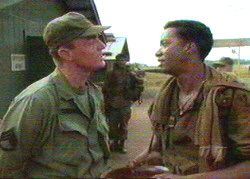 |
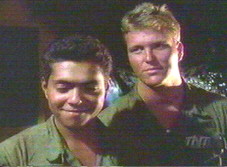 |

By Lee Russell
 |
 |

Among the things you had to do when out-processing was, if you were getting out of the Army, see the Reenlistment Counselor. This was a part-time job held by one of the rear-area sergeants. Hardly anyone wanted to "Re-Up" (reenlist, from the period Army reenlistment slogan) except the "lifers" the Career NCO's. They were staying in anyway, and Vietnam was a good place to do this. You wouldn't have to pay taxes on your reenlistment bonus, for example.
The information SSG Carlton provides is pretty much correct, Taylor would indeed get a free thirty day leave anywhere in the world for agreeing to stay in Vietnam for another six months. He could also sign up for any Army Training School he qualified for. He would undoubtedly be offered a promotion and several thousand dollars bonus, depending on how long he signed up for. This was fairly attractive to some. (My unit's supply clerk/armorer, for example, had reenlisted after six months in the Infantry and two battle wounds, for a rear-area job.) I did meet one soldier who decided to reenlist as he was out processing. (He was drunk at the time too, but did it without the assistance of the reenlistment NCO.) They had to sober him up to take the oath. However, when he discovered that he would have to spend a few more days in Vietnam to process the paperwork, he decided to get out instead. My part in this, aside from providing the above information to the writer, was in providing the period Reenlistment sign, a red, white and blue triangle with RE-UP ARMY on it, which appears on Carlton's door. It was too late to send a drawing by Fed Ex, so I described it over the phone for the prop people.
This episode is also unusual because it is set almost entirely at the Americal Division's Chu Lai rear base. The is the real "home" of the unit, but as infantry, they spend little time there. The cleaning woman ("hooch maid," a "hooch" was slang for your barracks or room) would not be there at night. With all the other Vietnamese workers, "Mama-San" would be brought out at dawn and taken back to her village late in the afternoon, by truck. The set is an excellent representation of a rear-area barracks, including the gray Navy-style bunks common in bases taken over by the Army from the Marines, such as Chu Lai.
We also see Taylor making a phone call home from the Chu Lai USO. This was usually done in the evening from the local Army communications radio station. (Called a MARS station-Military Affiliated Radio Station.) After hours, the Army radio operators would try to hook you up to a ham operator in the 'States, who would call your number collect from his own phone and patch you through.
The Viet Cong didn't try to walk around "in uniform" on US bases. Usually dressed as civilian workers, they would note the location of supply dumps or other targets, even pace off distances, for later attack. Sometimes, they would leave a booby trap or two.
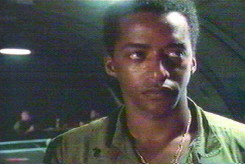 |
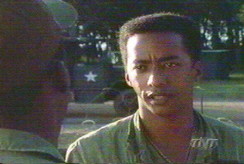 |
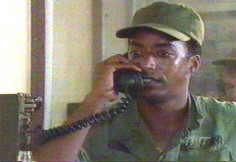
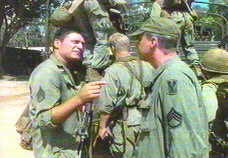 |
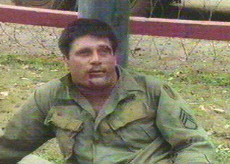 |
